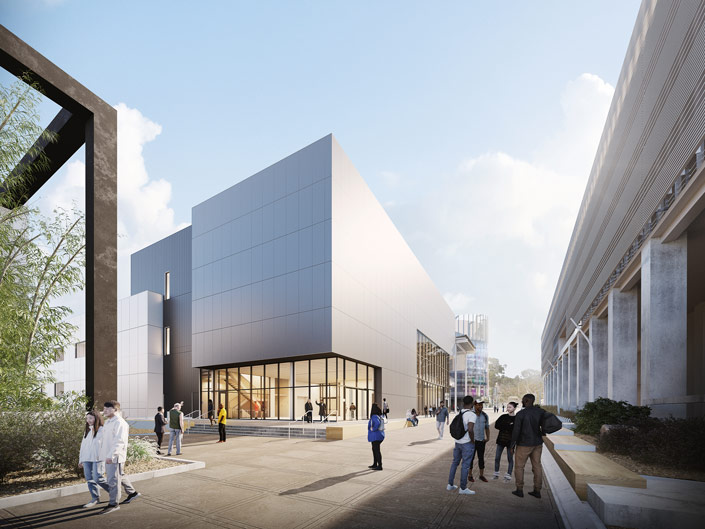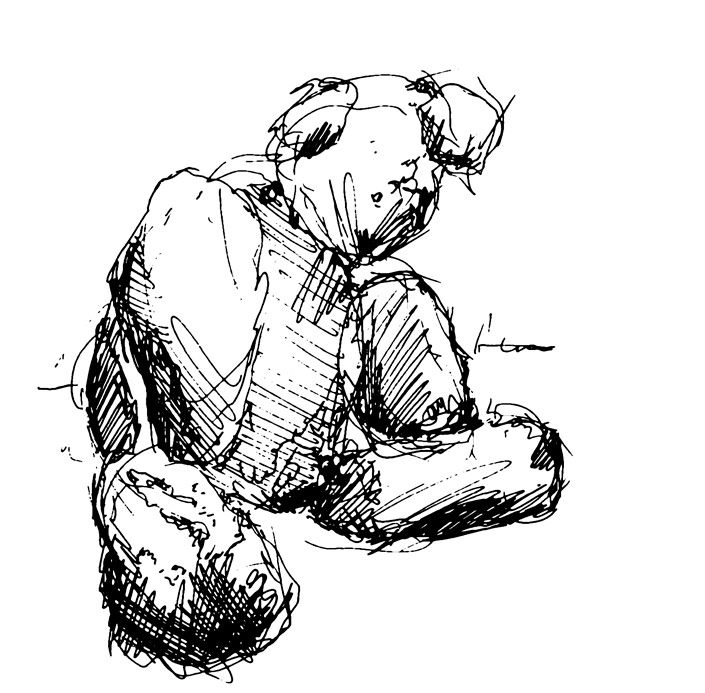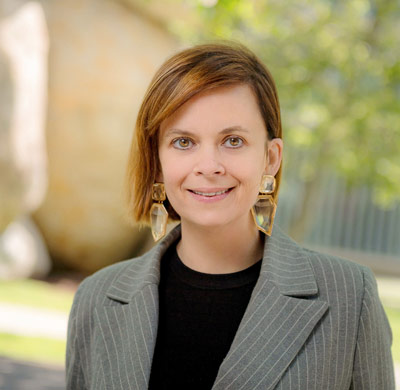UC San Diego Campus Arts Strategy Is Evolving
Already known — and beloved — for its large-scale art installations across campus, UC San Diego is expanding its programs and offerings, including a new gallery in the upcoming Triton Center: The Strauss.
Story by:
Published Date
Story by:
Share This:
Article Content
This article originally appeared in the fall 2024 issue of UC San Diego Magazine as “Campus Curated.”
It’s not uncommon for UC San Diego students to be greeted by multiple outdoor sculptures on their way to class. It may be a talking tree among the gray morning fog in the Eucalyptus Grove, or the bold and bright “Sun God” perched atop an ivy-lined archway amid a carpet of grass, or the bright neon reminders of “Vices and Virtues,” which run along the top of a laboratory building. It’s also the colorful murals in mosaic tiles or oil paint in the Student Union or along lecture halls. At UC San Diego, art is a part of our daily life.
Community Building
As the executive director and chief campus curator, Jess Berlanga Taylor, a bicultural and bilingual art professional, works closely with artists to find the most interesting, fun and experimental art to bring to UC San Diego. “Connecting artists and their work with our context here at UC San Diego opens a dialogue between the arts and the people who live and work on campus, generating a sense of place and identity,” she says.
Since arriving in April 2022, Berlanga Taylor has developed a new vision for maintaining existing artworks on campus while expanding the future of public art spaces at UC San Diego. For her, it’s about creating and strengthening community beyond the formal structures of the university. Part of that goal is also transforming UC San Diego into an arts and culture destination.
“A destination for the arts and culture is a powerful way of developing community and ensuring that it is resilient, supported, healthy and diverse,” says Berlanga Taylor. “I think of it as ‘radical hospitality,’ where people feel truly welcomed and cared for through the sharing of a range of experiences that art and culture offer, a hospitality that speaks to our shared humanity.”
The Strauss, slated to open in fall 2026, will be the latest addition to UC San Diego’s vibrant arts ecosystem. The gallery will be an environment of discourse and dialogue, much like other public art installations on campus.
Located in the upcoming Triton Center, The Strauss is named in recognition of a gift from the late Matthew Strauss, his wife, Iris, and their Strauss Family Foundation. At the gallery, contemporary art will meet science, technology and culture as visitors explore work across mediums by global artists and collectives. As a place of learning, The Strauss will utilize art to challenge a structured way of thinking. “Art benefits divergent thinking,” says Berlanga Taylor. “Creativity is at the heart of discovery and innovation.”
As part of the gift, the Strauss Family Foundation donated a world-class collection of contemporary art to UC San Diego. The collection comprises more than 100 pieces, ranging from paintings to mixed-media art to sculptures created by artists from around the globe, including pieces by renowned artists such as Zhang Huan, Fred Wilson, Sabine Moritz, Yin Xiuzhen, Nalini Malani, Ken Nolan, Donald Sultan, Jörg Immendorff, Ross Blechner and many more.
The collection will be on display in rotating exhibitions at The Strauss as well as on display throughout the new Triton Center.
The Future of Art
“A college campus is a place where young people are making career choices — whether in medicine, engineering, science, music or art,” said Matthew Strauss in 2023. “We feel that it is important for students to be exposed to world-class art, to expand their minds and learn abstract thinking at this stage in their lives.”
Matthew Strauss passed away this summer at the age of 91. He left an enduring legacy of impact at UC San Diego, which includes The Strauss as well as funding to fuel cancer research.
“A destination for the arts and culture is a powerful way of developing community and ensuring that it is resilient, supported, healthy and diverse.”
The Strauss will comprise five rooms, each distinct and with a vision of presenting the future of art. “Artists are working in a myriad of ways to address climate change, social justice, health and well-being, spirituality, immigration and technology — issues that are important to this campus,” says Berlanga Taylor. “We are building a space where art is placed at the intersection of science and technology that we hope will speak and reach out to the campus community and beyond.”
The Strauss will contain a series of named spaces:
The Lobby: This will be a welcoming space but with a twist. As soon as you set foot inside, you will be surrounded by art. “We want to collapse the distinction — the 18th-century model on which museums are built — between art in one place and life happening elsewhere,” says Berlanga Taylor. “Our intention is to create a dynamic, generous space in which art and community come together.”
The White Cube: This will be the most traditional space in the gallery. Art enthusiasts will find familiar wooden floors, white walls and lighting: the perfect setting for two-dimensional artworks. This space will host artwork from the Strauss Family Foundation and loaned collections and exhibitions from San Diego and around the country.
The Black Box: A multi-sensorial space where work will be presented as fully immersive experiences through video and sound.
The Gray Box: The largest room in The Strauss will host large-scale sculptures, video installations and other kinds of art.
Sculpture Terrace: An outdoor terrace on the gallery’s second floor will combine sculpture and green landscaping outside the confines of the building walls.

Reimagining Public Art
The Strauss is part of Berlanga Taylor’s reimagining of art on campus, including the renowned Stuart Collection.
The Stuart Collection began in 1981 and now includes 22 pieces of site-specific public art embedded into the landscape and culture of UC San Diego. In the past, the program focused on one project at a time — often taking years between new pieces. Berlanga Taylor has announced three new commissioning programs — the Landmarks Program, the Emerging Artists Program and the Public Program — to present art in a more dynamic and timely fashion.
The mission of the Stuart Collection remains unchanged. It will continue to commission artworks to expand its collection, mirror the university’s excellence and inspire students, scholars, staff and visitors.
The Landmarks Program will continue to include large-scale, outdoor permanent commissions by established artists.
The new Emerging Artists Program, launched in August 2024, is designed to bring new and diverse voices to UC San Diego to expand the existing Stuart Collection. The program aims to support experimental practices and explore ideas that embrace current cultural contexts that will resonate with local and international audiences. “These artists are young but already have an important track record,” says Berlanga Taylor. “A permanent commission in the Stuart Collection will certainly impact their careers.”
The Stuart Collection has selected the following people as the inaugural artists of the program: artist collective RojoNegro, composed of Noé Martínez and María Sosa; sculptor Max Hooper Schneider; and poet, artist and chef Precious Okoyomon. Each artist will complete their first permanent public art installation through the Emerging Artists Program. Three installations are expected to be completed between spring 2025 and fall 2026.
The Public Program will commission temporary artworks that could take the form of performances or art in action, masterclasses or workshops. In October, Jeppe Hein presented “Breathe with Me,” the first edition of the Public Program in collaboration with the Epstein Family Amphitheater that focused on art and mental health.


Berlanga Taylor believes public art offers a space for people to gather, discuss and debate. “Public art can be critical of our times but also playful and insightful. It serves to bring an awareness of our differences, our diverse cultures, who we are and how we think and act, ” she says. “But the opportunity always exists for us to come together.”
And while the use of public space can be contentious, these areas can be a place to develop skills, showcase identity and discuss today’s most critical issues.
The UC San Diego landscape is uniquely positioned to make space for this discourse, offering places for meaningful gatherings while helping to understand ourselves and each other better.
Share This:
You May Also Like
Stay in the Know
Keep up with all the latest from UC San Diego. Subscribe to the newsletter today.





